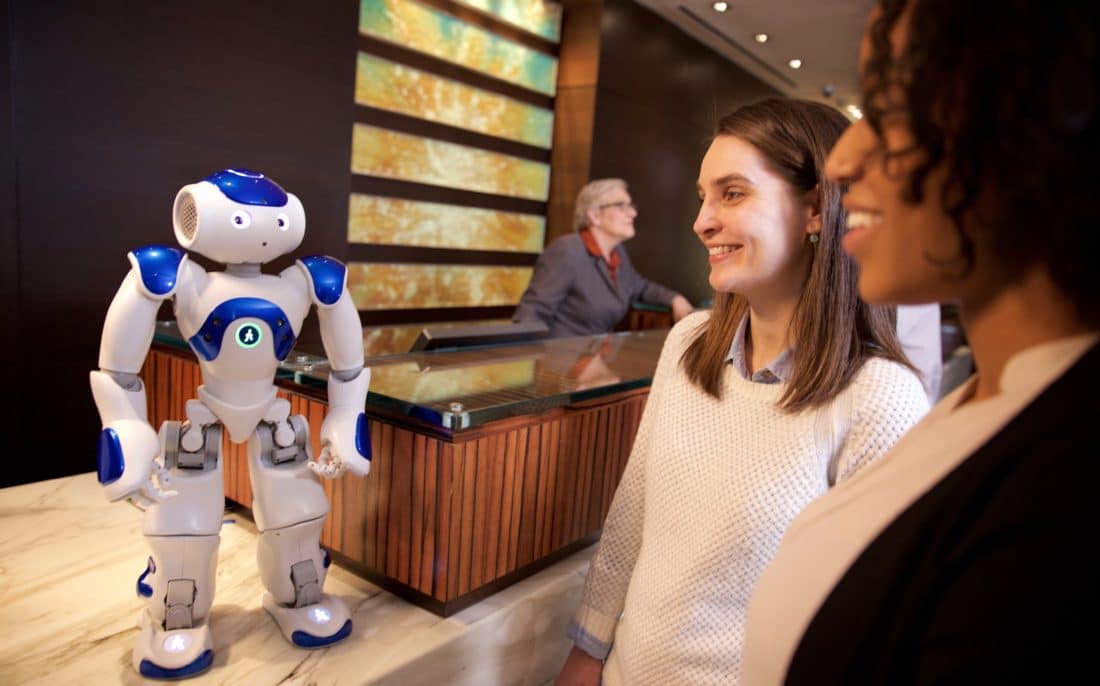The promise of new technologies is still unfulfilled, but that doesn’t mean the industry should not prepare for the day when artificial intelligence and augmented reality will drive consumer experiences, said speakers at a gathering of digital experts.
Adoption of artificial intelligence, virtual reality and voice-response systems is still a work in progress, but their potential to reshape marketing looms very large in next year’s plans among agencies and marketers, according to participants at the Adage Next conference. The annual event, formerly known as Ad Age Digital, featured a series of case studies, nearly all showcasing the use of technologies such as AR, VR or neuroscience to connect with consumers.
“People have to hug the machine,” said Bob Lord, chief digital officer of IBM.
Artificial intelligence is “about to unleash into the marketing and advertising world,” said Lord. He predicted in less than 5 years about 90% of agency marketing professionals will have science or web development backgrounds and encouraged marketers to learn code and try some projects, such as building a chat bot.
“All these new tools are at our disposal,” he said. “We just need to take advantage of them.” Lord noted IBM has left APIs for its Watson AI platform open to developers to try.
“It’s about how you access this open technology for machine learning,” he said. “You could be using it this afternoon”
AI comes in handy to parse data and in combination with other technologies such as heat mapping and brain scans, can analyze data and present it to agency staff for their use so they can create content faster and more accurately targeted to the audience, said speakers. The amount of data available today is too unwieldy for humans, said many speakers.
But anyone with “Terminator” fantasies about AI replacing humans can rest easy. For now, the technology can analyze data and perform functions such as natural language processing, but it’s not ready to replace agency creatives yet.
“AI is the promise of the future,” said Amy Hu, VP-interactive marketing of H&R Block. “It’s still old fashioned marketing, old fashioned segmentation… That has to have a human eye.” The technology is not at the stage that it can anticipate what the customer wants without human intervention, she said.
“Machines will not do the strategy for you… the creativity is still very human” said Or Shani, CEO of Albert, an AI marketing platform.
But while the technology catches up, humans need to adjust their thinking and train, said speakers. The new abilities to reach consumers through machine learning will require new skills, said Andrea McCullough, director, digital marketing and analytics at Dunkin Donuts.
“You now have AI co-workers,” said Shelly Palmer, CEO of the Palmer Group, an advisory firm. Every office has an unofficial AI expert, a techie who’s learned on their own how to perform some of the functions needed, he said.
“Figure out how to harness the power of AI,” said Palmer. “Become an expert, be that person.”
Organizations also have some things to figure out before leveraging AI and other sexy technologies, said speakers. First up, they need to have a reason for using it. Many companies have rushed headlong into developing chatbots and skills for Alexa, which have fallen flat and been a waste of their budgets, said speakers.
“Don’t look at the tech to solve the problem. Look at the problem,” said Matt Pritchard, Vp-digital acceleration at Campbell Soup Co. Any technology needs to be a part of an integrated campaign targeting a consumer need, he said.
“Technology for technology’s sake doesn’t work,” said Wendy Olson Killion, global senior director of Expedia Media Solutions.
Expedia uses neuroscience for research and used facial recognition technology to optimize a campaign for Hawaii tourism, but “we didn’t do it to do it first,” said Olson Killion.
The number one mistake brands make with chat bots is creating “very gimmicky stand-alone experiences” with no end goal, said Caroline Klatt, CEO of Headliner Labs.
“We don’t see chatbots as a very sexy thing,” she said. “It’s the way you need to think about communicating with customers. That sexy thing does not work.”
Machine learning is being used as a “third discipline” alongside media planning and creative at the agency level to enhance ideas and help with personalization, said Chris Pierantozzi executive creative director at Saatchi & Saatchi. The agency has teamed up with IBM’s Watson platform to create ads for Toyota. AI is a “supplemental palette,” he said.
Most speakers encouraged marketers to dive in and experiment. There are plenty of creation tools available, such as Apple’s AR Kit and Google’s ARCore, that put augmented reality within reach, said Mike Festa, director of Wayfair Next, the online retailer’s R&D team.
“Creating an app—I won’t say it’s easy, but it’s been done,” he said. Wayfair has been experimenting with applications that use AR technology and mapping to help shoppers with their purchases.
“Automation is here. It’s affecting anyone in this room and everyone in this world,” said Jess Kimball Leslie, global chief futurist at OgilvyRed. “It’s time to start talking about it and not let it hide in plain sight”
